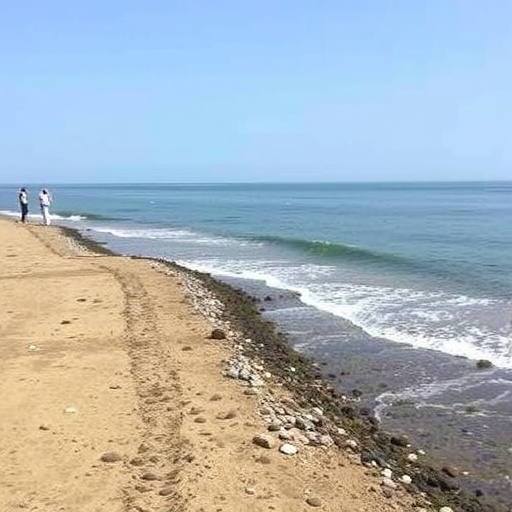In a groundbreaking study conducted by a team of researchers led by A.A. Basheer, significant insights have emerged regarding the geophysical health of the ecosystems along the coastline of Ras Gamila, Egypt. The research, which combines advanced geophysical methodologies and ecological assessments, aims to address pressing environmental issues while promoting sustainable coastal development. As coastal regions face increasing threats from climate change, pollution, and urban development, this study provides a timely examination of the relationship between human activities and the vitality of coastal ecosystems.
The importance of coastal zones cannot be overstated, as they support a myriad of biodiversity while also serving as critical resources for local communities. In this study, the research team systematically assessed the ecological health of the Ras Gamila area, utilizing a range of geophysical techniques aimed at capturing the complex interactions between natural systems and anthropogenic influences. Through this innovative approach, the team sought not only to classify the current state of the environment but also to provide actionable solutions that can enhance the region’s sustainability.
One of the pivotal aspects of this research involves the integration of various geophysical tools, including electromagnetic surveys, ground-penetrating radar, and remote sensing technologies. By employing these methods, the researchers were able to create a comprehensive picture of the subsurface characteristics and surface conditions of the coastal area. This integrated assessment is crucial for understanding the health of both terrestrial and marine ecosystems, which are often deeply interconnected.
The findings of this study are particularly relevant given the ongoing threats to coastal regions worldwide. Climate change has resulted in rising sea levels and increased ocean temperatures, which pose serious risks to habitats. Additionally, human activities such as industrialization, tourism, and resource extraction have further exacerbated these challenges. The research conducted at Ras Gamila provides a case study that illustrates how integrated geophysical assessments can be utilized to monitor and mitigate these environmental threats.
In addition to assessing the physical properties of the landscape, the researchers also evaluated the biological indicators of ecosystem health. This included studying the diversity and abundance of marine species, analyzing sediment samples, and investigating water quality parameters. The integration of biological assessments with geophysical data creates a holistic view of the ecological landscape, allowing for a nuanced analysis of the health of the coastal environment.
One of the study’s key outcomes is the identification of critical zones that require immediate intervention. By pinpointing areas that show signs of degradation or pollution, the research team has laid the groundwork for targeted conservation efforts. This approach not only addresses current environmental concerns but also promotes long-term sustainability by emphasizing the importance of proactive management techniques.
As the research progresses, it becomes evident that stakeholder involvement is essential for the success of any conservation initiatives. Local communities, government agencies, and environmental organizations must collaborate to implement the recommendations derived from this study. Engaging stakeholders ensures that the conservation strategies are economically viable, socially acceptable, and environmentally sound.
Furthermore, the research emphasizes the need for continuous monitoring of coastal environments. By establishing a long-term geophysical and ecological monitoring program, the area can be safeguarded against future threats. Real-time data collection and analysis will allow for quicker responses to emerging environmental challenges, paving the way for more adaptable management strategies that can evolve as conditions change.
The implications of this research extend beyond Ras Gamila. The methodologies and findings can serve as a template for other coastal regions facing similar ecological dilemmas. As global awareness of environmental issues grows, the necessity for innovative and integrated approaches becomes increasingly clear. Coastal sustainability is not just a regional challenge; it is a global imperative that calls for collaborative solutions.
The study also opens the door for future research opportunities. Many questions remain unanswered about the intricate relationships within coastal ecosystems and how they can be protected. The authors encourage further exploration into the impacts of climate change on marine biodiversity and ecosystem services. This research can contribute to broader efforts aimed at understanding human-environment interactions, thus fostering a more holistic view of coastal management.
In conclusion, the integrated geophysical health assessment conducted in Ras Gamila presents an invaluable framework for addressing coastal sustainability. With a focus on both environmental health and socio-economic factors, the research encapsulates the need for a comprehensive understanding of coastal ecosystems. As communities continue to navigate the challenges posed by environmental changes, studies like this highlight the importance of science-driven approaches in promoting both conservation and development.
The findings of this research not only contribute to the scientific understanding of coastal ecosystems but also provide essential guidance for policy-making and resource management. By prioritizing the health of these critical environments, we can ensure that future generations inherit thriving coastal communities and ecosystems.
With the publication of this significant research in Sci Rep, policymakers, environmentalists, and local populations are now equipped with the knowledge to forge a path towards sustainable coastal development. The call to action is clear: we must commit to the conservation of our coasts, integrating scientific insights with community engagement, to foster resilience in the face of ongoing environmental changes.
Subject of Research: Integrated geophysical health assessment for eco-development and coastal sustainability in Ras Gamila, Egypt.
Article Title: Integrated geophysical healthy assessment for eco development and coastal sustainability in Ras Gamila, Egypt.
Article References:
Basheer, A.A., Darwish, Z.M.A., Mohamed, A. et al. Integrated geophysical healthy assessment for eco development and coastal sustainability in Ras Gamila, Egypt.
Sci Rep (2025). https://doi.org/10.1038/s41598-025-26234-3
Image Credits: AI Generated
DOI: 10.1038/s41598-025-26234-3
Keywords: Coastal sustainability, geophysical assessment, ecosystem management, Ras Gamila, environmental monitoring, climate change adaptation.
Tags: advanced geophysical methodologiesanthropogenic influences on natural systemsclimate change impact on coastlinescoastal sustainability in Egyptecological health assessment techniqueselectromagnetic surveys for ecological monitoringgeophysical health assessmentpollution effects on coastal ecosystemsRas Gamila environmental studyremote sensing in environmental researchsustainable coastal development strategiesurban development and biodiversity





